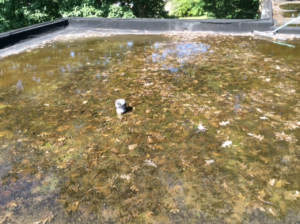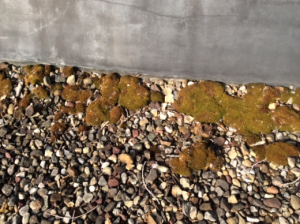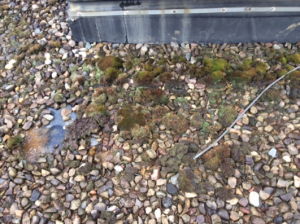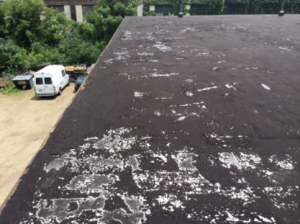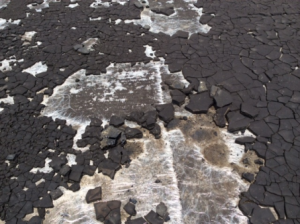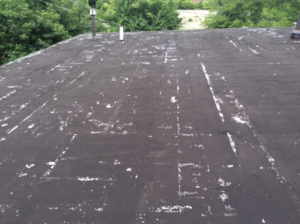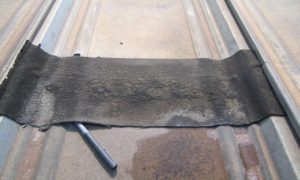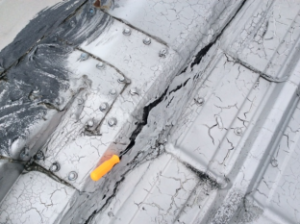Common Roof Problems

Chalking
Chalking is a powdery residue on the roof surface resulting from degradation of that material from exposure. It is NOT from settled dirt. Chalk must be removed by cleaning in order for the applied coatings to have proper adhesion.
The best way to clean your roof is to power-wash the surface. Simply sweeping the roof surface to remove dirt is ineffective. We recommend you scrub the roof with water and TSP (Trisodium Phosphate) solution to remove all dirt, oils, grease and chalk.
TIP: Before coating begins, roof surface should be checked with tape to see if it is really clean. If the tape pulls off tight and evenly, the surface is clean. If the tape pulls off easily, with loose material filling the area, it needs more cleaning.
NOTE: If no amount of cleaning produces an adequate tape pull, a primer should be considered.
Mildew, Moss, or Mold
The three M’s Mildew, Moss and Mold, are usually fuzzy, greenish or bluish-grayish-white and THEY’RE ALIVE. Cement and tile roofs are especially prone to mildew because they contain minerals which are needed to support growth. Generally, shaded area and areas of poor drainage allow mildew to grow.
To protect your roof, provide proper drainage and expose shaded areas to sunlight where possible. Susceptible areas that cannot be corrected should be cleaned with a chlorine bleach solution twice each year.
PREPARATION
Clean the roof surface by power-washing or scrubbing with TSP (Trisodium Phosphate). Treat mildewed areas with a chlorine bleach solution. Rinse the entire surface thoroughly and let dry.
Follow the Kool Seal easy 3-Step Process for the Kool Seal Elastomeric Coating System:
- Patch with Kool Seal Storm Patch® Acrylic Patching Cement or Kool Seal Storm Patch Black Patch and Coat
- Reinforce with Kool Seal Storm Patch® Polyester Fabric
- Top coat with Kool Seal White Elastomeric Roof Coating
Moss: very small plants that grow in velvety, green clusters on damp surfaces.
Mold: a downy or furry growth on the roof surface caused by fungi, especially in the presence of dampness or decay.
Mildew: a fungus that can appear on a surface when exposed to dampness, it appears as a thin, furry, whitish discoloration.


Alligatoring
Alligatoring on a built-up roof (or BUR) is a term for a pattern of cracks similar to an alligator’s skin.
It is important to seal your roof as soon as you see signs of alligatoring. If the surface is left unprotected, it can deteriorate beyond a point where a roof coating will be effective.
PREPARATION
Scrape off loose previous coating. Clean the roof with water and TSP (Trisodium Phosphate) . Rinse thoroughly and let dry.
REPAIR
Coat all cracks and blisters with Kool Seal Storm Patch Acrylic Patching Cement or Kool Seal Storm Patch Black Patch and Coat. Use Kool Seal Storm Patch Polyester Fabric to reinforce patching cement on all cracks.
Badly Degraded Built-Up Roof
If your roof looks like this, see a roofing professional and have it replaced. This is what happens to asphalt if it’s left exposed and unprotected.
PREVENTION
The best way to prevent this from happening to your roof is to patch and reinforce all cracks with Kool Seal Storm Patch Black Patch & Coat or Kool Seal Storm Patch Acrylic Patching Cement and Polyester Fabric. Top coat with Kool Seal Elastomeric White Roof Coating early, before deterioration becomes severe.
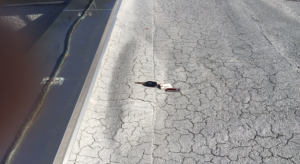

Blistering
Like Blister on your skin, blisters on a built-up roof (or BUR) occur when water gets trapped under the top layers of the surface.
With a bit of work you can eliminate this problem from your roof. If in doubt, consult a certified Roofing Professional.
PREPARATION
Scrape off loose previous coating. Clean the roof with water and TSP (Trisodium Phosphate) available at most hardware stores. Rinse thoroughly and let dry.
REPAIR
On blistered areas, cut an X through the entire blister and allow moisture to evaporate and dry thoroughly before patching. Patch with Kool Seal Storm Patch Acrylic Patching Cement or Kool Seal Storm Patch Asphalt Patch & Coat, the use Kool Seal Storm Patch Polyester Fabric to reinforce patching cement over the blister and on all cracks.
Top coat with a Kool Seal Elastomeric White Roof Coating System for the best performance.
Loose Lap
Pictured left is a condition known as loose lap. It occurs on rolled roofing. With a bit of work you can eliminate this problem from your roof. If in doubt, consult a certified Roofing Professional.
PREPARATION
Prepare the surface per package directions.
REPAIR
Secure loose laps in place with Kool Seal Storm Patch Acrylic Patching, and then use Kool Storm Patch Polyester Fabric to reinforce patching cement on all cracks. Top coat with a Kool Seal Acrylic Elastomeric Roof Coating System or Aluminum Roof Coating System for the best performance.

Fishmouthing
Pulling felt during application, using felt with damp edges, or flattened rolls may cause laps to lift or have scalloped, wavy edges. This condition is known as “fishmouthing”.
If left unattended, fishmouths may allow water penetration into the roofing system.
With a bit of work you can eliminate this problem from your roof. If in doubt, consult a certified Roofing Professional.
TO REPAIR SMALL FISHMOUTHS
PREPARATION:
If loose edges extend back only a couple of inches, the loose material may be snipped off and discarded.
REPAIR:
Seal with Kool Seal Storm Patch Acrylic Patching Cement and reinforce with Kool Seal Storm Patch Polyester Fabric Then top coat the entire roof surface with a Kool Seal Acrylic Elastomeric Roof Coating System or Aluminum Roof Coating System for the best performance
TO REPAIR LARGE FISHMOUTHS
PREPARATION:
If the fishmouths are more than 2” deep, cut the membrane down the middle of the fishmouth until well adhered material is found. Trim flaps so they lie flat.
REPAIR:
Seal with Kool Seal Storm Patch Acrylic Patching Cement and reinforce with Kool Seal Storm Patch Polyester Fabric. Then top coat the entire roof surface with a Kool Seal Acrylic Elastomeric Roof Coating System or Aluminum Roof Coating System for the best performance.

